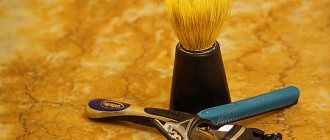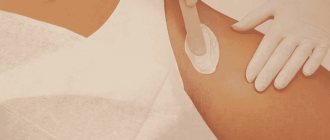A modern woman carries out a whole range of self-care procedures almost every day. Well-groomed and smooth legs are beautiful and attractive!
But is it really necessary to remove hairs every 2-3 days in order to maintain their beauty? Modern hair removal methods will help remove excess hair on your legs for 2-3 weeks, you just need to choose the right procedure for yourself.
You can keep your legs smooth at home
The essence of the waxing procedure
The depilation procedure using wax paste involves superficial removal of hair, in which the follicles under the skin remain unaffected. In the process of removing a strip of material, the root with the outer part of the hair is pulled out, and each time there is a slight traumatic effect on the bulb. Preserving the integrity of the follicle is a significant difference between this method and the hair removal procedure, in which subcutaneous elements are destroyed, and subsequent hair regrowth becomes impossible.
After the hair removal procedure, hair growth is almost impossible, since the follicles were affected
Waxing is an ancient invention. Its prototype is hair removal with a special composition, including beekeeping products. This method was used by queens in ancient Egypt.
Using wax, you can treat the entire surface of the legs or perform depilation of one of the areas: the lower leg or the area above the knee. This depends on the thickness and individual location of the hair. So, for some people in the lower leg area they are denser and stiffer than on the upper part of the leg and vice versa. In the knee area, depilation is more difficult due to the uneven surface, but this can be solved with the correct technique.
Hair removal with wax is more painful in the area above the knee than on the lower leg. Although individual sensitivity depends on many factors, including the temperature and consistency of the wax used. Also, with each session, the sensations that cause discomfort are dulled, and the skin gets used to this method of depilation.
With wax you can remove hair only on the lower leg or all over the entire leg, it all depends on your preference
In addition, if you regularly use wax, the hair structure changes. They thin and weaken, making them soft and pliable and making the procedure easier. Over time, the length of the interval between sessions increases as hair growth slows down.
During the procedure, wax at the required temperature is applied to a small area of skin, and then in one movement the mixture is pulled off in the direction of hair growth.
It is in the direction of hair removal that waxing differs from sugaring. With sugar depilation, the paste is removed according to hair growth, and not against it.
The result after waxing on the legs lasts approximately 4-5 weeks. It is possible to reduce this period depending on the specific characteristics of the body. The next procedure is usually carried out after 5-6 weeks, when the hair reaches a length of 5 mm.
Waxing allows you to completely get rid of hair on your legs for a long time.
Conclusion
Regardless of the hair removal method you choose, its success, duration of action, effectiveness, and safety depend on how responsibly you take skin care and adherence to certain restrictions after manipulation. Otherwise, processes will develop on the skin that will not only make it unaesthetic, but also cause discomfort, and in some cases can even cause serious harm to health. Therefore, it is important to pay no less attention to the care of the epidermis than to the hair removal process itself.
How to choose a leg wax depending on the type of procedure
Depilation of the surface of the legs can be carried out using types of wax that differ from each other in consistency, heating temperature and release form. Depending on the material used, the following types of waxing are distinguished:
- hot;
- warm;
- cold.
Hot depilation
When removing leg hair with hot wax, the procedure is effective and least painful. The high temperature of the composition allows you to remove the toughest and densest vegetation, and the maximum opening of the pores facilitates the process of removing hairs. However, in this case there is a high risk of getting burned. Therefore, at least for the first time, it is recommended to entrust the procedure to a professional in the salon.
Hot wax must be heated to a temperature of 50–60 °C
Warm depilation
For home use, wax at a temperature of about 40 °C is optimal. The procedure using such material is called warm depilation. It is impossible to burn yourself with wax unless you overheat it, and the soft consistency of the composition allows you to completely eliminate both dense and soft hair on any part of the legs, including the knees.
Warm wax comes in cartridge form, making it easy to apply. It is very convenient for removing hair from the flat surface of the legs. Cassette wax is heated before application in a special wax melter, usually included in the kit.
Wax in cartridges is best suited for home hair removal of legs.
Cold depilation
The simplest depilation option is to use strips with cold wax applied to them. They are suitable for getting rid of thin and soft hair on the legs. The effectiveness of this method may be low, since cold material does not grip hair as well as warm or hot material. Also, depilation using strips is a rather painful procedure. But cold wax is as safe as possible, since it eliminates the risk of getting burned.
Ready-made strips with cold wax can easily be used for depilation at home.
Depilation of hairs on legs using a thread
There is an original method for removing unwanted hair using regular thread. It will help out if you have already waxed your legs, and then noticed that you missed a few hairs while away from home. Take a thread 10-20 cm long, tie the ends, put it on the thumb and index fingers of both hands. In the middle you need to twist it several times, then press it to the skin and tighten the knot several times. The hairs will wrap around the thread and break out.
Preparation in the procedure
In order for the waxing session to go as efficiently as possible and with the least pain, it is necessary to specially prepare the surface of the legs:
- 2 days before the procedure, perform a thorough peeling, and avoid visiting the bathhouse, sauna, solarium or beach and avoid excessive cooling of the skin.
- Take a shower an hour before waxing without using cosmetics.
- After the skin has dried, apply an antiseptic (Miramistin, Chlorhexidine, etc.) to your feet.
- For better adhesion of wax to hair, use talc or baby powder.
- If you have sensitive skin or are performing the procedure for the first time, you can use painkillers. For example, Lidocaine or Emlu. The drug must be spread over the surface of the legs an hour before the procedure and covered with film so that it is better absorbed into the skin. You can also take a tablet (Ibuprofen, Tempalgin, Nurofen) 40 minutes before the session.
To numb the surface of your legs before depilation, use Emla cream.
Before waxing, be sure to test for allergies to the components of the wax composition. To do this, apply a little mass to your elbow and observe the skin reaction for 10 minutes. If it does not turn red or itch, then you can begin depilation.
For waxing, the hair on your legs must grow by 5 mm. On excessively long vegetation, the procedure will be difficult and painful. If the hair is under 5mm, the wax will not adhere to it properly.
Depilation kit
Materials and devices for the procedure must be prepared in advance, including:
- disposable spatula, preferably wooden;
- wax in a form convenient for you;
- fabric or paper strips;
- wax melter or container for melting the composition in a water bath;
- antiseptic (Miramistin, Chlorhexidine, etc.);
- moisturizing cream.
How to get rid of hair using folk remedies
As a replacement for expensive salon procedures, you can use traditional methods of removing vegetation. For this, soda, hydrogen peroxide, ammonia, lime, Rivanol, etc. are used.
The disadvantage of traditional methods is low efficiency and adverse skin reactions.
Hydrogen peroxide
Concentrated hydrogen peroxide allows you to discolor and thin the hairs, making them invisible and facilitating depilation. The following methods are used to weaken hair:
lubricating the feet with a 10% peroxide solution 2 times a day; applications with ammonia and flour (50 ml of peroxide and 10 drops of ammonia are thickened with flour and kept on feet for 15 minutes); applications with soap (2 tsp each of liquid soap and peroxide with 10 drops of ammonia, leave for 15 minutes). Applications should be done no more than once a week.
Soda
Baking soda is an alkaline salt, so it creates an environment on the skin that is unfavorable for hairs and follicles. Compresses with soda are used to remove or weaken hairs:
0.5 tsp dilute soda with 100 ml of warm water; moisten gauze folded in several layers with the solution; wrap the compress around the leg and cover the top with cling film. The compress should be applied at night.
Rivanol
Rivanol is an antiseptic based on ethacridine lactate and boric acid. The first component negatively affects the hair structure, destroying it and damaging the follicle.
Rivanol is applied twice daily. Some users of the method note rapid hair loss and long-term retention of the effect. The disadvantages of the method include strong staining of the skin and the lack of product for free sale.
Other recipes
The following components are also used to remove vegetation:
- green nuts;
- potassium permanganate;
- slaked lime;
- a mixture of iodine, ammonia and castor oil.
How to wax your legs at home
For home leg hair removal, it is better to choose warm or cold wax. This is especially true for those who are trying this method for the first time.
Try to perform the waxing procedure in the evening, since irritated skin needs time to recover and calm down. Night is the optimal time for this.
Depilation with hot or warm wax
Waxing on legs using heated wax looks like this:
- Bring the mixture to a temperature of 55–60 °C if it is in a jar or in granules. In case of using cassette wax - up to 40 °C. To do this, you can use a special heater or water bath.
- Use a spatula to grab a little mixture from the heated jar and carefully spread it in a thin layer over the skin along the hair growth. If you use wax in a cassette, simply roll the roller along the surface of your leg, also following the hair growth.
- Place a bandage on top and press it, which should be larger in size than the area with wax.
- Wait about 20-30 seconds for the wax to form a thick, hardened layer.
- Grabbing the bandage by the edge with one hand and firmly pressing the skin next to it with the other, remove the strip with a sharp movement against the hair growth parallel to the skin.
- Perform the same sequence of actions on other parts of the legs. The composition can be distributed simultaneously over several areas.
- Get rid of excess wax using cotton pads soaked in cosmetic or vegetable oil.
- Apply moisturizer to your skin.
When using wax in a cartridge, you don't need a spatula to apply it - just roll the roller over your leg
To work the surface of the legs in the bending area, you should tighten the skin. In this case, the wax will be able to penetrate into all folds and grooves, and the bandage will lie flat.
During waxing, it is important to remove the bandage with a sharp movement, otherwise the quality of the procedure will decrease
Video: how to perform leg depilation with wax in a cartridge
Cold wax depilation
Cold depilation technique:
- Place the wax strip between your palms and rub it for a minute.
- Place the tape on the skin area and smooth it along the hair growth.
- After 3-5 seconds, holding the skin on one edge, grab the bandage and sharply remove it against the hair growth.
- If the hair is not completely removed the first time, simply glue the strip again.
- Treat your skin with oil and apply moisturizer.
Wax strips are suitable for beginners and those who are afraid of getting burned
As a rule, 8 short or 6 long strips are required for one shin, and 18 small or 14 long strips are required to treat the entire leg.
Some manufacturers produce special post-waxing oils that remove residue from the skin and soothe it.
Video: how to use wax strips
Skin care after waxing
After waxing, you need to take measures to avoid redness, inflammation, bruising or ingrown hairs:
- Do not use talc after the procedure as it clogs the pores.
- Apply anti-ingrown hair products to your skin.
- Treat your skin with a scrub 2 days after waxing to reduce the risk of ingrown hairs.
- If redness, bruising or burning occurs, soothe the skin with a decoction of chamomile or calendula.
- For 2 days after the procedure, do not wear tight clothes made of synthetic fabrics, and also refuse to take a bath, go to the bathhouse or sauna, visit the solarium, or actively tan.
- Do not treat your skin with alcohol-containing products or rub it.
Anti-ingrown hair products usually contain fruit acids, which remove the top layer of skin
Is it possible to do foot sugaring yourself?
You can do foot sugaring yourself. But in order to properly perform the sugaring procedure on yourself, you need to have at least a little experience.
You must be able to select the density of the paste, the position and technique of applying the caramel layer.
The advantages of home sugaring of feet are only available to those who know how to prepare the paste themselves and are familiar with all the intricacies of the procedure - in this case, the advantage of treating your feet yourself is to save time
(preparing pasta takes less time than going to the salon) and money.
But in the absence of the necessary knowledge, skills and abilities, a home procedure will be more expensive than salon sugaring (the average cost of professional foot treatment is 2,100 rubles, the price of a high-quality paste is from 1,500 rubles.
You will also need to constantly buy consumables and skincare products. And if you don’t use them up within a year, they will simply lose their shelf life. And you will need to do 10-15 procedures per year.).
Sugaring your armpits yourself at home: paste, technique, mistakes and care
Sugaring mustache yourself at home: paste, technique, mistakes and care
Contraindications
Avoid waxing or consult your doctor first if you have:
- diabetes;
- low blood clotting;
- phlebeurysm;
- allergic reactions to the composition used;
- any skin damage on the legs, including scratches and pimples.
- warts and other skin growths.
During pregnancy, you need to be careful about waxing, as there is a high risk of unexpected reactions to the painful procedure.
During pregnancy, it is better not to perform waxing without consulting a specialist.











